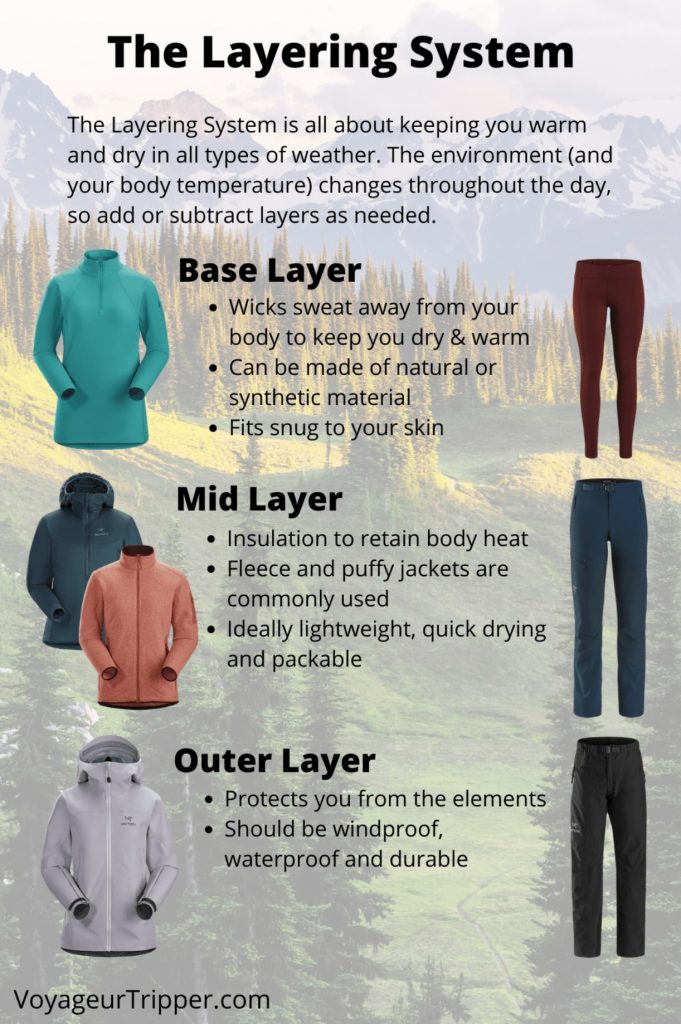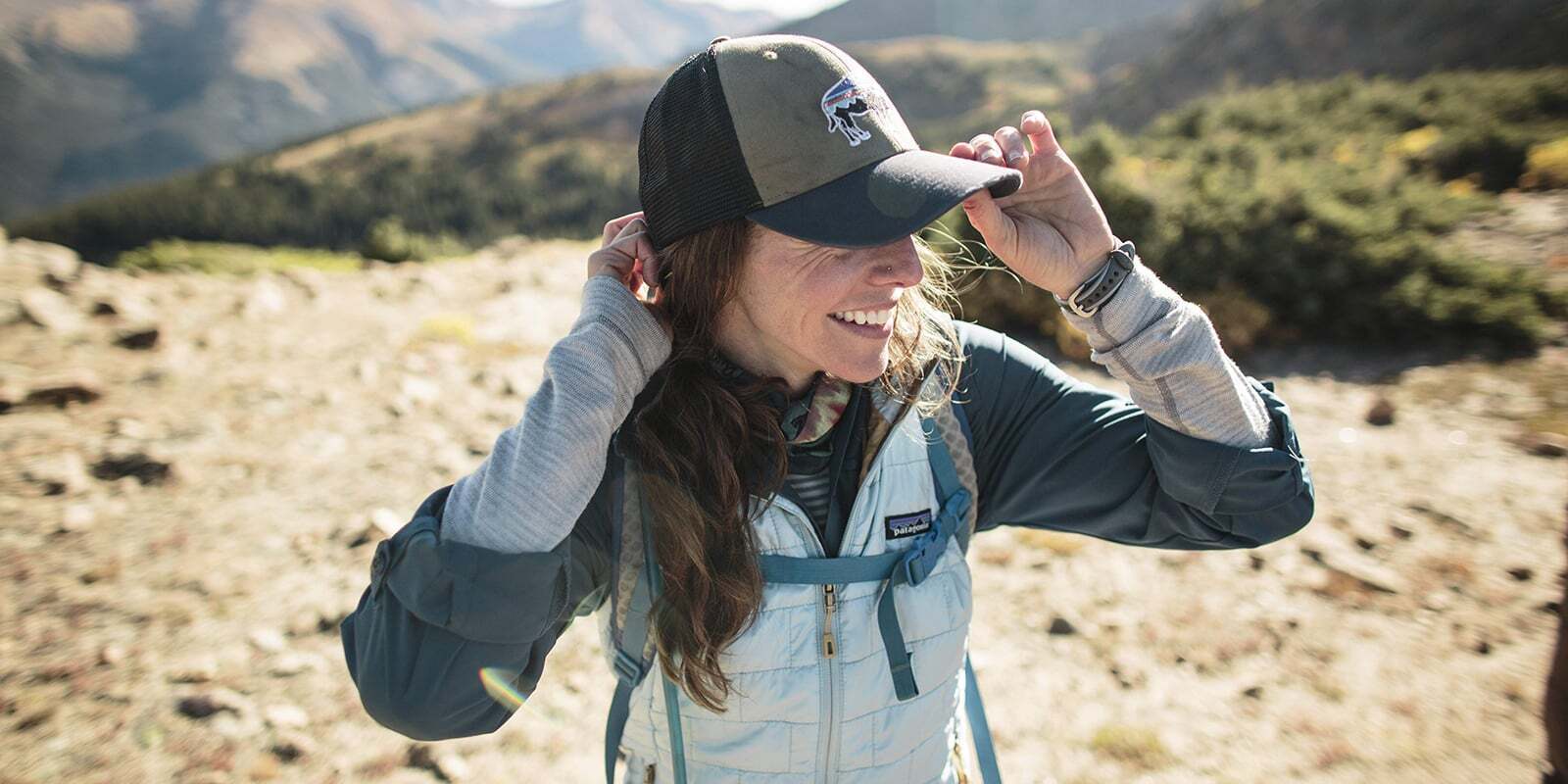The Complete Guide to Hiking Clothes: What to Wear for Every Adventure
After 15 years of hiking through every terrain and weather condition imaginable, I've learned that choosing the right hiking clothes can make or break your outdoor adventure. From my first cotton t-shirt disaster on Mount Washington to perfecting my layering system on the Pacific Crest Trail, this comprehensive guide shares everything I've discovered about what to wear hiking. Whether you're planning a day hike or multi-day backpacking trip, you'll find expert advice and tested recommendations at Explore National Parks Store.
The Essential Layering System

Understanding the layering system is crucial for selecting the right hiking clothes. After countless miles on trails from the Appalachian Mountains to the Rocky Mountain peaks, I've discovered that proper layering is the foundation of outdoor comfort and safety. The three-layer system consists of a moisture-wicking base layer, an insulating mid-layer, and a protective outer shell.
The beauty of this system lies in its adaptability. When I started my sunrise hike up Mount Katahdin last fall, I wore all three layers as temperatures hovered around freezing. By midday, as the sun warmed the exposed granite, I stripped down to just my base layer. This flexibility is what separates experienced hikers from beginners who find themselves overheating or underdressed.
Temperature regulation is everything on the trail. Your body generates significant heat during exertion, and the wrong hiking clothes can trap moisture, leading to hypothermia in cold conditions or heat exhaustion in warm weather. I learned this lesson the hard way during an early spring backpacking trip in the White Mountains, where cotton clothing nearly ended my hiking career before it truly began.
Modern hiking clothes utilize advanced synthetic materials and merino wool that wick moisture away from your skin while providing insulation even when damp. Brands like Patagonia, Arc'teryx, and REI Co-op have revolutionized outdoor apparel with fabrics that are lighter, more durable, and more effective than ever before. The investment in quality best hiking clothes pays dividends in comfort and performance over thousands of trail miles.
Base Layers: Your Foundation
Moisture-Wicking Tops
The base layer serves as your skin's best friend on the trail, and choosing the right material makes all the difference. After testing dozens of different base layers over the years, I consistently return to merino wool and high-quality synthetic blends. These materials excel at moving sweat away from your body while maintaining their insulating properties even when damp.
My go-to base layer for most conditions is the Smartwool Merino 150 Base Layer. This lightweight merino wool shirt has accompanied me on everything from desert hikes in Joshua Tree to alpine adventures in Glacier National Park. The natural odor resistance of merino wool means I can wear it for multiple days without offensive smells, crucial for backpacking trips.
User Review Summary: "I've been using Smartwool base layers for three years of intensive hiking. They're incredibly comfortable, never smell, and the temperature regulation is perfect. Worth every penny for serious hikers." - Reddit user u/TrailRunner2023
For budget-conscious hikers, synthetic options like the REI Co-op Merino Wool Long-Sleeve Base Layer provide excellent performance at a fraction of the cost. During my recent section hike of the Colorado Trail, I wore this base layer for 12 consecutive days and was impressed by its durability and moisture management.
Bottom Base Layers
Base layer bottoms are often overlooked but equally important, especially for winter hiking clothes and cold-weather adventures. I prefer lightweight merino wool leggings that can be worn under hiking pants or shorts depending on conditions. The key is finding a fit that doesn't bunch or create pressure points under your pack's hip belt.
Hiking Pants and Shorts

Selecting the right hiking pants or shorts depends on your specific adventure, terrain, and personal preferences. Over the years, I've developed strong opinions about what works and what doesn't based on real-world trail experience across diverse environments.
For versatility, nothing beats convertible pants. My REI Co-op Sahara Convertible Pants have been my constant companion on multi-day trips where weather conditions vary dramatically. The ability to zip off the legs when temperatures rise or brush gets thick has saved me countless times. These pants have excellent pocket placement, durable construction, and the quick-dry fabric performs admirably in various conditions.
For dedicated summer hiking clothes, I recommend lightweight hiking shorts with built-in sun protection. The inseam length should prevent chafing while allowing full range of motion. Quality hiking shorts feature moisture-wicking fabric, secure pockets, and reinforcement in high-wear areas.
Pro Tip from Personal Experience: Always test your hiking clothes on shorter day hikes before committing to longer adventures. I learned this during a disastrous 5-day backpacking trip where new pants caused severe chafing by day two.
Fabric choice significantly impacts performance and durability. Synthetic blends with nylon and polyester provide excellent durability and quick-drying properties, while some cotton blends can work for casual day hiking in moderate climates. However, I strongly advise against pure cotton for serious hiking, as it retains moisture and loses insulating properties when wet.
For hiking clothes for men and hiking clothes women, fit considerations differ slightly. Men often prefer looser cuts for better ventilation, while women frequently prioritize more tailored fits that don't compromise mobility. Both should focus on comfort, functionality, and protection from the elements.
Insulation and Mid-Layers
Fleece and Soft Shell Jackets
Mid-layers provide crucial insulation when temperatures drop, and the right choice depends on your specific hiking conditions. During my recent traverse of the John Muir Trail, I carried both a lightweight fleece and a packable puffy jacket, using each in different situations throughout the 22-day journey.
Fleece jackets excel in active conditions where you need warmth but generate significant body heat. My trusty Patagonia Better Sweater Fleece Jacket has been a reliable companion for thousands of trail miles. It breathes well during moderate exertion, provides excellent warmth-to-weight ratio, and maintains insulation even when damp from perspiration or light precipitation.
Soft shell jackets bridge the gap between insulation and weather protection. They typically feature a DWR (durable water repellent) coating that sheds light precipitation while providing wind resistance and moderate warmth. I find soft shells most useful during shoulder seasons when weather conditions frequently change.
Down and Synthetic Insulation
For maximum warmth with minimal weight, down insulation remains unmatched in dry conditions. However, synthetic insulation maintains warmth when wet, making it better for humid environments or unpredictable weather. I carry a synthetic puffy jacket for most three-season hiking and reserve down for dry, cold conditions or winter adventures.
User Review Summary: "My synthetic puffy has saved me multiple times when caught in unexpected rain. Unlike down, it kept me warm even when soaked. Essential for Pacific Northwest hiking." - Quora user, experienced backpacker
The Outdoor Research Transcendent Down Hoody represents the gold standard for packable warmth. I've used this jacket from desert nights in Big Bend to alpine conditions in the Cascades, and its performance never disappoints. The hood provides crucial head warmth, and the packability allows it to disappear into my backpack when not needed.
For those seeking lightweight hiking clothes, modern insulation layers achieve remarkable warmth-to-weight ratios. Some of my favorite pieces weigh less than a pound while providing enough warmth for all but the most extreme conditions.
Weather Protection and Shell Layers

Shell layers serve as your first line of defense against wind, rain, and snow. After being caught in numerous unexpected storms, I never venture into the backcountry without proper shell gear, even on seemingly perfect days. Weather in the mountains changes rapidly, and being prepared has kept me safe and comfortable countless times.
Waterproof-breathable shells represent the pinnacle of weather protection technology. These garments use membranes like Gore-Tex, eVent, or proprietary fabrics that block external moisture while allowing internal water vapor to escape. During a particularly brutal storm on Mount Whitney, my Arc'teryx Beta AR Jacket provided complete protection while maintaining breathability during the strenuous ascent.
For best hiking clothes for women and best hiking clothes for men, shell selection should prioritize fit and functionality over fashion. A properly fitting shell allows for full range of motion while accommodating insulation layers underneath.
Rain pants complete the weather protection system. While often overlooked by day hikers, they're essential for serious backpacking and extended outdoor exposure. Quality rain pants feature full-length side zips for easy on/off over hiking boots, reinforced areas in high-wear zones, and adequate room for base layers.
Ranger Advice: During my conversation with a veteran ranger at Yellowstone, she emphasized that proper rain gear has prevented more rescues than any other single piece of equipment. Hypothermia can occur even in summer when hikers get wet and cold.
Budget considerations shouldn't compromise safety. While premium shells cost more, they typically offer better durability, breathability, and weather protection. However, excellent budget options exist for occasional hikers. The key is understanding your specific needs and investing accordingly.
Maintenance extends shell life significantly. Regular washing with technical detergents, reapplying DWR treatments, and proper storage keep shells performing at their best. I refresh the DWR coating on my shells annually, ensuring optimal performance when I need it most.
My Personal Experience and Recommendations
Lessons Learned from 15 Years on the Trail
My relationship with hiking clothes has evolved dramatically over the past 15 years. Starting with cotton t-shirts and jeans (a mistake I deeply regret), I've gradually built a collection of technical apparel that has proven itself across diverse conditions and challenging terrain.
One pivotal moment occurred during a late-season hike in the White Mountains. Temperatures dropped unexpectedly, and my cotton clothing became dangerously cold when damp with sweat. A fellow hiker shared his extra merino wool base layer, quite literally saving me from hypothermia. That experience taught me the critical importance of proper fabric selection and sparked my journey toward understanding technical outdoor apparel.
Through trial and error, I've discovered that quality hiking clothes are an investment in safety, comfort, and enjoyment. My current go-to setup includes merino wool base layers, convertible hiking pants, a lightweight fleece, and a packable shell. This system adapts to most three-season conditions while remaining lightweight and compact.
User Review Summary: "After reading countless gear reviews, I finally invested in quality hiking clothes. The difference is night and day - no more overheating, chafing, or being caught unprepared for weather changes." - Amazon verified purchaser
Seasonal Considerations
Each season demands specific approaches to hiking clothes selection. Spring hiking requires versatility as conditions change rapidly. I typically start with multiple layers that can be adjusted as temperatures rise throughout the day. Cheap hiking clothes can work for beginners, but investing in quality pieces pays dividends over time.
Summer hiking focuses on sun protection, ventilation, and moisture management. Long-sleeve shirts with UPF protection, lightweight pants, and breathable fabrics become essential. I've learned that covering exposed skin often feels cooler than wearing minimal clothing due to sun protection and reduced water loss.
Fall hiking brings unpredictable weather and the need for adaptable layering systems. This season showcases the importance of having quality merino wool hiking clothes that perform in varying conditions. Winter demands specialized gear and understanding of cold-weather physiology, topics that deserve dedicated attention.
Brand Recommendations Based on Real Use
After testing gear from dozens of manufacturers, certain brands consistently deliver exceptional performance. Patagonia excels in environmental responsibility and innovative materials. Arc'teryx provides uncompromising technical performance for demanding conditions. REI Co-op offers excellent value and wide size ranges. Smartwool remains my top choice for merino wool base layers.
For those seeking hiking clothes sale opportunities, end-of-season clearances and outlet stores provide access to premium gear at reduced prices. Building a quality hiking wardrobe takes time and patience, but the investment enhances every outdoor experience.
Conclusion
Choosing the right hiking clothes transforms your outdoor experiences from potentially miserable ordeals into comfortable adventures. Through years of trial and error, gear testing, and countless miles on diverse trails, I've learned that quality hiking apparel is an investment in safety, comfort, and enjoyment.
The fundamental principles remain consistent: prioritize moisture-wicking fabrics, embrace layering systems, invest in quality pieces for frequently used items, and always prepare for changing conditions. Whether you're seeking cool hiking clothes for summer adventures or survival clothes for challenging expeditions, understanding these principles guides wise purchasing decisions.
Remember that hiking clothes should enhance your outdoor experiences, not hinder them. Start with essential pieces, build your collection gradually, and prioritize function over fashion. The trails await, and with proper clothing, you'll be prepared for whatever adventures lie ahead.
As you plan your next hiking adventure, consider your specific needs, local conditions, and personal preferences. The perfect hiking outfit varies by individual and circumstance, but the guidelines in this comprehensive guide provide a solid foundation for making informed decisions. Safe travels, and may your hiking clothes serve you well on many memorable adventures!
Frequently Asked Questions
What are the best fabrics for hiking clothes?
The best fabrics for hiking clothes are moisture-wicking synthetics like polyester and nylon, or natural fibers like merino wool. These materials excel at moving sweat away from your skin while maintaining insulation properties when damp. Avoid cotton for serious hiking, as it retains moisture and loses warmth when wet. Synthetic blends offer durability and quick-drying properties, while merino wool provides excellent temperature regulation and natural odor resistance. Choose fabrics based on your specific hiking conditions, with lighter weights for warm weather and heavier constructions for cold conditions.
How should I layer my hiking clothes?
Proper layering follows the three-layer system: base layer, insulation layer, and shell layer. Start with a moisture-wicking base layer against your skin, add insulating mid-layers as needed for warmth, and top with a waterproof-breathable shell for weather protection. This system allows you to add or remove layers as conditions change throughout your hike. Begin your hike feeling slightly cool, as your body will warm up quickly during exertion. The key is having layers you can easily adjust without stopping for extended periods or removing your pack.
What should I avoid wearing while hiking?
Avoid cotton clothing, especially jeans and cotton t-shirts, as they absorb moisture and lose insulation when wet. Skip new, untested clothing on important hikes, as it may cause chafing or discomfort. Avoid restrictive clothing that limits movement, jewelry that could snag on branches, and inappropriate footwear like flip-flops or fashion sneakers. Also avoid overdressing initially, as you'll warm up quickly during physical activity. Pure cotton socks lead to blisters, and non-breathable synthetic materials can cause overheating. Choose technical hiking-specific clothing designed for outdoor activities instead.
How much should I spend on hiking clothes?
Investment in hiking clothes should match your hiking frequency and conditions. For occasional day hikers, budget-friendly options from retailers like REI Co-op or discount outdoor brands provide adequate performance. Serious hikers benefit from investing in premium base layers, quality rain gear, and durable hiking pants. Plan to spend $200-500 for a complete three-season hiking wardrobe, prioritizing key pieces like base layers and shell layers. Sales, outlet stores, and end-of-season clearances offer opportunities to acquire quality gear at reduced prices. Remember that quality hiking clothes last many years with proper care, making them cost-effective over time.
Do I need different clothes for different seasons?
Yes, different seasons require adapted clothing strategies. Spring hiking needs versatile layers for changing conditions, while summer focuses on sun protection and ventilation. Fall demands warm layers and weather protection as temperatures drop and storms increase. Winter requires specialized insulation, waterproof shells, and understanding of cold-weather layering. However, a well-chosen core wardrobe works across three seasons with additions for specific conditions. Quality base layers, convertible pants, and waterproof shells adapt to most spring through fall conditions. Add insulation layers and cold-weather accessories for winter hiking adventures.